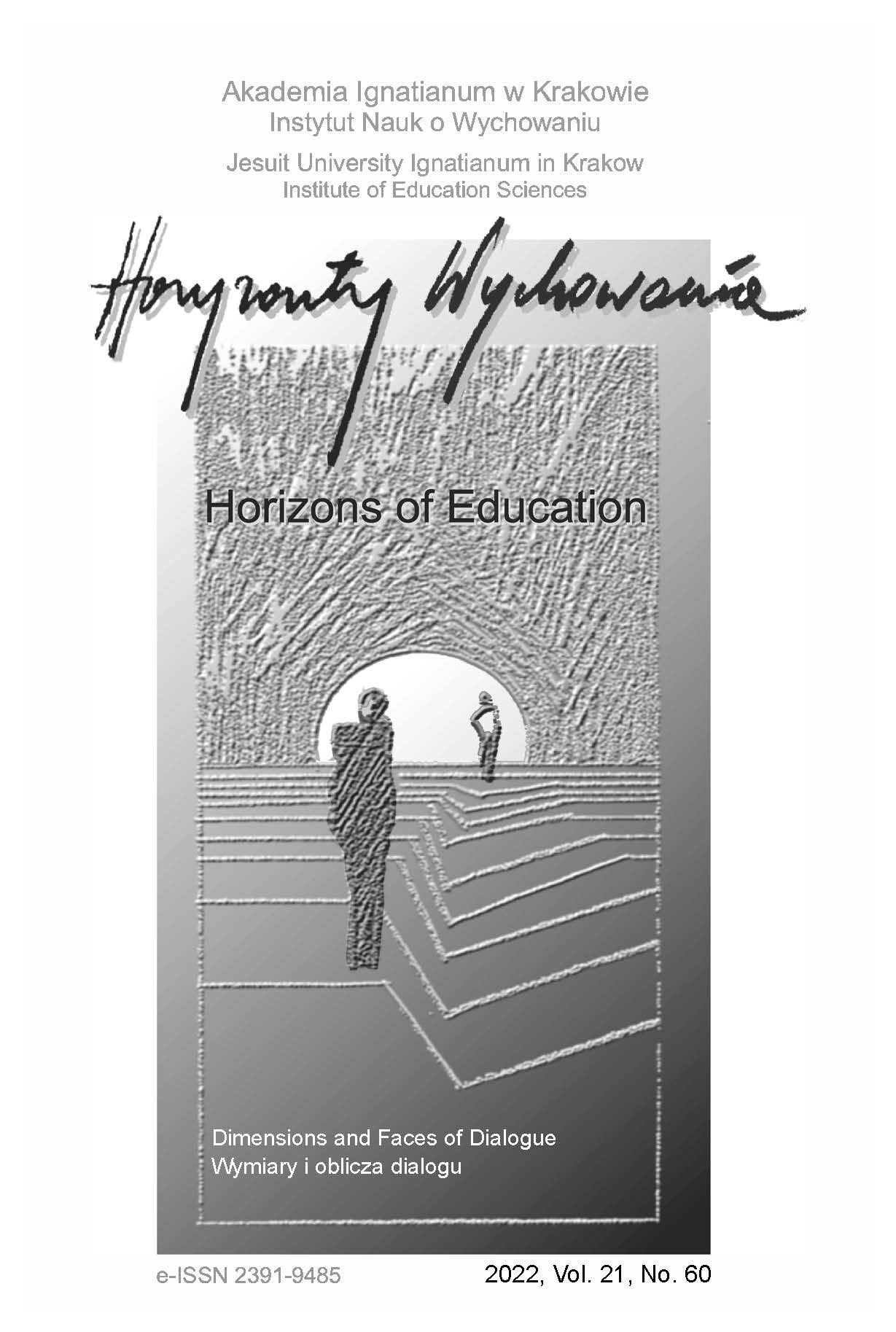Pursuit Eye Movements in the Context of Speech Development in Children with ASD
Abstrakt
CEL NAUKOWY: Celem prezentowanych badań była ocena wolnych ruchów śledzenia dzieci pięcio- i sześcioletnich z ASD w kontekście rozwoju mowy.
PROBLEM I METODY BADAWCZE: Problematyka badawcza dotyczy aktywności okoruchowej badanych dzieci z ASD w sytuacji śledzenia obiektów wolno poruszających się w polu widzenia. Sformułowane pytania badawcze odnoszą się do związków pomiędzy ruchami śledzącymi a dynamiką rozwoju mowy badanych, jak również aktualnymi umiejętnościami badanych w tej sferze. W badaniach zastosowano technikę eye trackingu.
PROCES WYWODU: Zaprezentowane zostały podstawowe informacje dotyczące procesu widzenia, ze szczególnym uwzględnieniem roli ruchu śledzącego. Dokonano prezentacji badań na temat znaczenia ruchu gałek ocznych w procesie nabywania umiejętności komunikacyjnych, budowania relacji społecznych i skutecznego działania.
WYNIKI ANALIZY NAUKOWEJ: Przedstawiono wyniki dotyczące korelacji pomiędzy zmienną niezależną (wzorzec wolnego ruchu śledzenia prezentowany przez badanych) a dynamiką rozwoju zaburzenia oraz poziomem rozwoju mowy badanych w odniesieniu do analiz innych autorów.
WNIOSKI, INNOWACJE, REKOMENDACJE: Przeprowadzone analizy ujawniły silne i umiarkowane korelacje pomiędzy zmiennymi i pozwoliły na potwierdzenie hipotezy głównej, zakładającej, że zapisy ruchu oka podczas śledzenia wolno poruszających się obiektów we wszystkich płaszczyznach odznaczają się zmiennością związaną z dynamiką rozwoju mowy we wczesnym dzieciństwie oraz prezentowanymi obecnie przez badanych nieprawidłowościami w tym obszarze. Uzyskane wyniki wskazują na konieczność jak najwcześniejszego podjęcia treningu widzenia u dzieci z ASD.
Bibliografia
Auyeung, B., Baron-Cohen, S., Wheelwright, S., & Allison, C. (2008). Autism Spectrum Quotient (AQ) (Child). Journal of Autism and Developmental Disorders, 38, 1230-1240. https://www.autismresearchcentre.com/tests/autism-spectrum-quotient-aq-child/
Białecka-Pikul, M., Białek, A., Stępień-Nycz, M., & Karwala, M. (2014). Odkrywanie kompetencji komunikacyjnych niemowląt. Skala Wczesnej Komunikacji Społecznej jako przykład narzędzia pomiarowego. Psychologia Rozwojowa, 19(3), 51-68. https://ruj.uj.edu.pl/xmlui/bitstream/handle/item/6717/bialecka-pikul_karwala_stepien-nycz_bialek_odkrywanie_kompetencji_komunikacyjnych_niemowlat_2014.pdf?isAllowed=y&sequence=1
Błeszyński, J.J., Lubińska-Kościółek, E., & Zielińska, J. (2019). Zastosowanie techniki eye trackingu w diagnozie dzieci z zaburzeniami ze spektrum autyzmu. Wydawnictwo Naukowe Uniwersytetu Pedagogicznego. https://ipskn.up.krakow.pl/wp-content/uploads/sites/18/2021/11/Eyetracking-ksiazka.pdf
Cierpiałowska, T., & Lubińska-Kościółek, E. (2017). Ocena predyktorów rozwoju kompetencji i sprawności komunikacyjnych i językowych w pierwszym roku życia dziecka – uwagi do procesu wczesnej diagnozy. Annales Universitatis Paedagogicae Cracoviensis. Studia Paedagogica, 9, 14-29.
Howard, P.L., Zhang, L., & Benson, V. (2019). What can eye movements tell us about subtle cognitive processing differences in autism? Vision (Basel), 3(2), 22. https://www.ncbi.nlm.nih.gov/pmc/articles/PMC6802779/
Jaklewicz, H. (1993). Autyzm wczesnodziecięcy, diagnoza, przebieg, leczenie. Gdańskie Wydawnictwo Psychologiczne.
Klin, A, Jones, W., Schultz, R., Volkmar, F., & Cohen, D. (2002). Visual fixation patterns during viewing of naturalistic social situations as predictors of social competence in individuals with autism. Archives of General Psychiatry, 59(9), 809-816. https://jamanetwork.com/journals/jamapsychiatry/fullarticle/206705
Leigh, R.J., & Zee, D.S. (2006). The neurology of eye movements. Oxford University Press.
Milner, A.D., & Goodale, M.A. (2008). Mózg wzrokowy w działaniu (G. Króliczak, Trans.). Wydawnictwo Naukowe PWN.
Oleszczyńska-Prost, E. (2011). Zez. Elsevier Urban & Partner.
Park, J.P, Schauder, K.B., Kwon, O., Bennetto, L., & Tadin, D. (2021). Atypical visual motion prediction abilities in autism spectrum disorder. Clinical Psychological Science, 9(5), 944-960. https://pubmed.ncbi.nlm.nih.gov/34721951/
Rubacha, K. (2008). Metodologia badań nad edukacją. Wydawnictwa Akademickie i Profesjonalne.
Scharre, J.E., & Creedon, M.P. (1992). Assessment of visual function in autistic children. Optometry and Vision Science, 69(6), 433-439. https://pubmed.ncbi.nlm.nih.gov/1641224/
Stagg, S.D., Linnell, K., & Heaton, P. (2014). Investigating eye movement patterns, language, and social ability in children with autism spectrum disorder. Development and Psychopathology, 26(2), 1-9. https://www.researchgate.net/publication/260758577
Takarae, Y., Minshew, N., & Luna, B. (2005). Pursuit eye movement deficits in autism. Brain, 127(12), 2584-2594. https://www.researchgate.net/publication/8206891_Pursuit_eye_move- ment_ deficits_in_autism
Uwe, J.I. (2002). Commentary: Smooth pursuit eye movements: from low-level to high-level Vision.
Progress in Brain Research, 140, 279-298. https://pubmed.ncbi.nlm.nih.gov/12508597/
Winczura, B. (2013). Zaburzenia rozwoju mowy i komunikacji u małych dzieci z autyzmem. Dylematy wczesnej diagnozy autyzmu. In B. Winczura (Ed.), Dziecko o specjalnych potrzebach komunikacyjnych. Diagnoza – eduakcja – terapia. (pp. 35-52). Oficyna Wydawnicza „Impuls”.
Winczura, B. (2018). Wczesne rozpoznawanie zaburzeń ze spektrum autyzmu – symptomy ryzyka, diagnoza wstępna, badania przesiewowe. Interdyscyplinarne Konteksty Pedagogiki Specjalnej, 22, 69-99. https://doi.org/10.14746/ikps.2018.22.05
Copyright (c) 2022 Horyzonty Wychowania

Utwór dostępny jest na licencji Creative Commons Uznanie autorstwa – Bez utworów zależnych 4.0 Międzynarodowe.
Uwagi dotyczące praw autorskich
Autorzy publikujący w tym czasopiśmie wyrażają zgodę na następując warunki:
- Autorzy zachowują prawa autorskie, przyznając czasopismu prawo do pierwszej publikacji swojego tekstu jednocześnie zarejestrowanego pod numerem licencji CC BY-ND, która pozwala innym na korzystanie z tego tekstu z uznaniem autorstwa tekstu oraz pierwotnej publikacji w tym czasopiśmie.
- Autorzy proszeni są o nawiązywanie odrębnych, dodatkowych porozumień wynikających z umowy, dotyczących dystrybucji opublikowanej w czasopiśmie wersji tekstu nie na prawach wyłączności (np. opublikowanie go w repozytorium instytucji lub w innym czasopiśmie), z potwierdzeniem pierwszej publikacji w tym czasopiśmie.
Wyraża się zgodę i zachęca autorów do publikacji ich tekstu w Internecie (np. w repozytorium instytucji lub na jej stronie internetowej) przed lub podczas procesu składania tekstu jako, że może to prowadzić do korzystnych wymian oraz wcześniejszego i większego cytowania opublikowanego tekstu (Patrz The Effect of Open Access). Zalecamy wykorzystanie dowolnego portalu stowarzyszeń badawczych z niżej wymienionych:





